8 Best Calibers for
Self Defense

If you want a lively debate, just ask a group of gun owners the best caliber for self defense. You’re likely to get as many viewpoints as there are people in the discussion. The choice of caliber for home defense is just part of the equation, along with your choice of gun, powder charge, and all the other associated ballistics.
I had a friend cut an alfalfa field for me one summer, and he broke down, a common occurrence out here on the farm. He called to ask me for a ride to get his truck so he could repair his swather. As I pulled up he climbed out of the cab with an AR-15 slung over his shoulder. “That in case you see a coyote,” I asked.
“Not all predators are four-legged,” Levi replied.
That’s the essence of self defense, whether it’s in your home, on the highway, the street, or in Levi’s case, on a large piece of farm equipment.
What to Look for in a Self Defense Caliber
We’re talking about caliber, but you’ll also read about gauge. Simply put, both are metrics for determining the size of the bullet, or the bore of the shotgun. Caliber is the measurement of the diameter of a barrel in fraction of inches, gauge is a more obscure measurement of how many lead balls the diameter of a shotgun bore it takes to weigh a pound.
Why is caliber or gauge an important consideration? The answer is it determines the effective stopping power of a gun, it indicates how strong a recoil can be when firing the gun, and it determines what type of handgun, shotgun, or combination of the two you can use. Those are all key considerations.
The caliber should be sufficient to stop the intruder, criminal, or perpetrator with a single shot. In the heat of the moment, you may not be nearly as accurate as you are on the range with stationary paper targets. If you only hit your attacker with a single round you want it to be enough to disable them and protect yourself, your family, or your property with that single shot.
The lower range for self defense calibers should start with the .38 special, and extend to the .44 Magnum in revolvers and pistols. A 12-gauge shotgun is the standard, though 16 and 20-gauge shotguns do just fine a close range. With this in mind, let’s walk through the various calibers, and gauges, and rate each one in effectiveness, ease of use, recoil, availability of weapons’ platform and add an intimidation factor, something you might want to consider when thwarting an attacker without deploying deadly force.
Features to look for in a self-defense caliber:
- Stopping power – Measured in caliber or gauge
- Recoil – Can you handle the force?
- Range – How far is it effective?
- Handgun – How big is it? How heavy?
- Magazine capacity – How many rounds?
- Shotgun – How long and heavy a gun can fire this shell?
The .38 Special
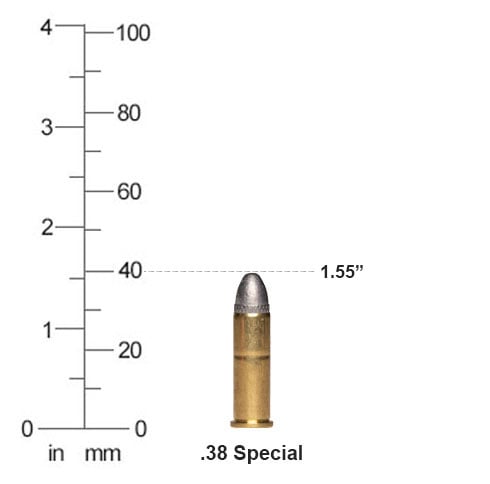
This is the caliber Sergeant Joe Friday carried on Dragnet and the police standard for generations. The magic of the .38 special is that the ammunition is inexpensive and in ready supply. If you’ve heard that you can shoot .357 magnum cartridges from a .38 revolver, think again.
Many people confuse this issue. It is true that you can shoot .38 special cartridges from a .357 magnum revolver. However, firing a .357 magnum cartridge from a .38 special will result in an explosion and possible loss of fingers. Don’t do it. It’s best to shoot the ammunition a weapon is designed to use, not experiment.
The .38 special has ample stopping power, doesn’t have tremendous recoil, and has been a mainstay in personal defense for a long time. You can fire it from snub-nosed or long barreled revolvers equally well.
.38 Special Features
| Energy Measured in Foot Pounds at 50 Yards | 215 |
| Energy Measured in Foot Pounds at 100 Yards | 176 |
| Recoil | Moderate |
| Penetration 1-5 (light to heavy) | 3 |
| Effective Range in Yards | 50 |
The .357 Magnum
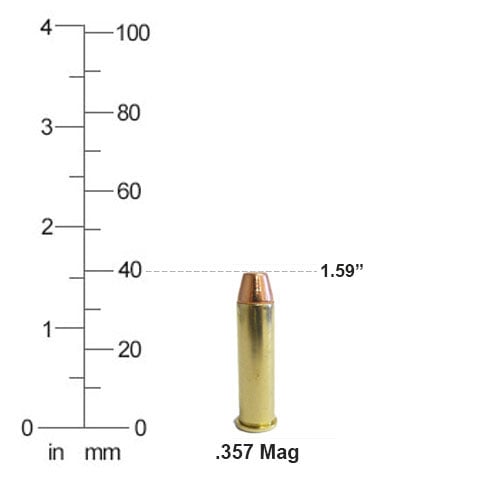
The sexy, Hollywood induced image of any magnum, particularly the .357 and its big brother, the .44 magnum make it a popular caliber, partly due to its publicity, but also due to its stopping power.
A .357 magnum makes a lot of noise when it’s fired, and it makes a big exit wound when it goes through a target. The .357 magnum delivers substantially more force than the .38 special, almost twice as much, and is a ballistic powerhouse in a small sized handgun.
The large energy, fired from a smaller, lighter weight handgun can produce a lot of recoil, too much for many people, even when they’re holding it with both hands. The power and intimidation factor of a .357 magnum are legendary. The marksmanship many shooters lack with this cartridge is the stuff of legends as well.
This is a great caliber if you have the wherewithal to control it, take the time to practice with it, and can reliably hit targets with it, both moving and stationary.
.357 Magnum Features
| Energy Measured in Foot Pounds at 50 Yards | 478 |
| Energy Measured in Foot Pounds at 100 Yards | 376 |
| Recoil | Heavy |
| Penetration 1-5 (light to heavy) | 4 |
| Effective Range in Yards | 75 |
The Venerable .40 Caliber
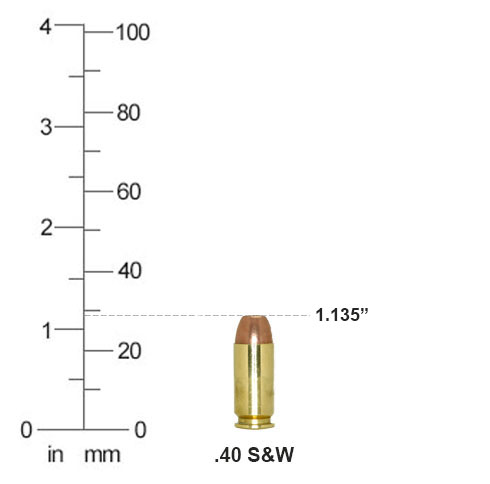
This ubiquitous caliber was once all the rage with military, police, government agencies, and the common person looking for a great self defense caliber. Thanks to marketing by the manufacturers of 9mm handguns, the venerable .40 caliber has suffered some image problems.
Don’t kid yourself, the .40 caliber remains one of the best calibers for self defense on the market. The availability of .40 caliber ammunition, its low price, and the myriad platforms built to handle this widespread caliber keep it at the head of the class.
In comparison tests, the .40 caliber does well against its more popular, much more publicized rival, the 9mm, but it just doesn’t have the glamour of the 9mm, which is generated largely by television and action feature films.
Many police forces and military units have abandoned the .40 caliber for the 9mm, but many have not, realizing its potential as an outstanding personal protection caliber. The .40 caliber does everything the 9mm does, just without the fancy wrapping.
.40 Caliber Features
| Energy Measured in Foot Pounds at 50 Yards | 387 |
| Energy Measured in Foot Pounds at 100 Yards | 329 |
| Recoil | Moderate |
| Penetration 1-5 (light to heavy) | 3 |
| Effective Range in Yards | 60 |
The 9mm
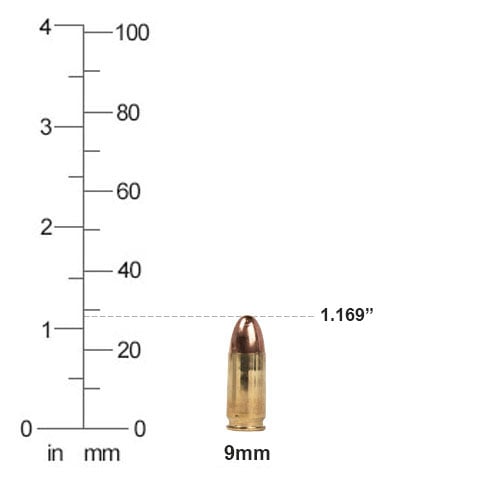
Ok, here it is, the favorite of Hollywood, many police officers, special forces personnel, and the imagination of far too many gun enthusiasts who have jumped on the bandwagon of popularity, without doing the necessary ballistic homework.
Not to be mistaken, the 9mm is an excellent choice in a self defense caliber. It is widely available, widely marketed, and the most popular cartridge in the world at present.
The only knock on the 9mm is that some consider it not powerful enough to stop an enraged, or drug crazed attacker. It is true that sometimes 9mm rounds don’t penetrate deeply when hitting certain parts of the body, but that’s also true of the .38 special and the .40 caliber.
The wide range of manufacturers, styles of handguns, and pricing from bargain basement to exotic make this an excellent choice in a self defense cartridge.
9mm Features
| Energy Measured in Foot Pounds at 50 Yards | 224 |
| Energy Measured in Foot Pounds at 100 Yards | 189 |
| Recoil | Light |
| Penetration 1-5 (light to heavy) | 3 |
| Effective Range in Yards | 50 |
The .45 ACP
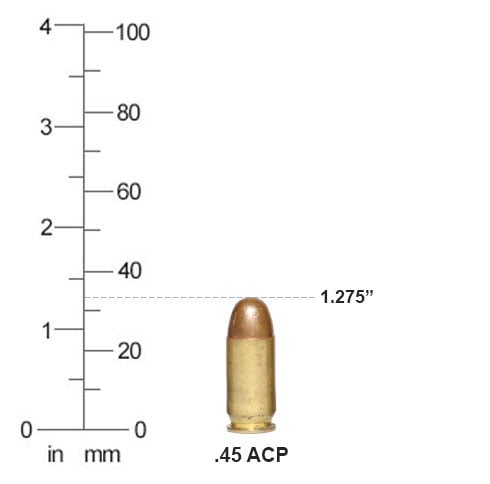
It’s hard to beat a .45 ACP for stopping power. That’s the reason John Browning invented the 1911 model pistol in the first place: to knock people down.
Hopefully you don’t think you’re Dirty Harry, but that Clint Eastwood film now approaching half-a-century in age, made the .44 magnum a household name. If you’ve ever had the chance to fire on, you know what power is the second you pull the trigger.
The .45 ACP delivers a slower, much heavier bullet than any of the other calibers in this review, and it’s that bone crunching 200, 225, or 230 grain bullet that delivers the energy to knock the biggest, angriest man on the planet backward when it hits.
The .45 ACP will penetrate doors, walls, and brush more efficiently than the competition as well.
.45 ACP Features
| Energy Measured in Foot Pounds at 50 Yards | 421 |
| Energy Measured in Foot Pounds at 100 Yards | 388 |
| Recoil | Moderate/Heavy |
| Penetration 1-5 (light to heavy) | 4 |
| Effective Range in Yards | 75 |
The .44 Magnum
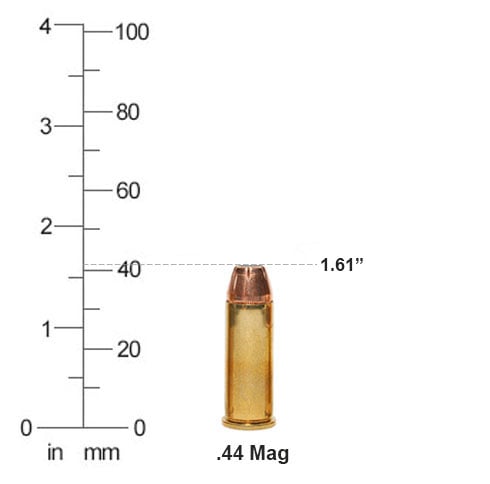
Hopefully you don’t think you’re Dirty Harry, but that Clint Eastwood film made the .44 magnum a household name. If you’ve ever had the chance to fire one, you know what power is the second you pull the trigger.
A .44 magnum with the proper bullet can penetrate engine blocks, disable getaway cars, and punch through steel doors, car fenders, and walls with ease. It kicks like a mule too.
If you choose a .44 magnum as a self defense weapon, make sure you shoot it often at the range and get used to the recoil. Someone just grabbing one and firing away as if it were a .22 long rifle or 25 caliber pistol soon discovers the less than friendly kick of its tremendous recoil. Many novices have pulled the trigger and had the gun fly from their hands.
If you’re after intimidation you won’t find anything better in handgun ammunition than the .44 magnum, it makes a huge hole in whatever it hits as well.
.44 Magnum Features
| Energy Measured in Foot Pounds at 50 Yards | 806 |
| Energy Measured in Foot Pounds at 100 Yards | 684 |
| Recoil | Extreme |
| Penetration 1-5 (light to heavy) | 5 |
| Effective Range in Yards | 100 |
The 12 Gauge
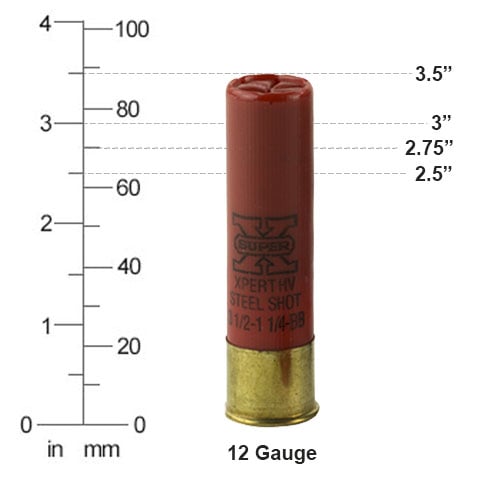
There was a scene in the 1970s police sitcom “Barney Miller” when an arrested suspect says to his partner, “I had a shotgun, doesn’t that mean anything anymore?” Yes, it does. For pure intimidation without ever firing a shot, the bore on a 12-gauge shotgun will get someone’s attention.
Wyatt Earp called it a “street howitzer” for a reason. The 12-gauge shotgun delivers over an ounce of lead, fired at speeds above 1000 feet per second, and is the most deadly self defense weapon you can own. There is no substitute for what a 12-gauge shotgun can do at ranges less than 50 yards.
The caveat with a 12-gauge is that it comes with a larger, harder to wield shotgun. The shotgun in skilled hands is unsurpassed as a self defense weapon. If there is a madman breaking into your home and you hear him coming up the stairs to your room, you don’t have to wait for the door to break open, you can dispatch him right through the door, it is that powerful.
The 12-gauge is the most common cartridge sold in America after the .22 long rifle. It’s easy to use, available on hundreds of models of shotguns, and delivers a lethal dose of lead from two feet to 50 yards.
.12 Gauge Shotgun Features
| Energy Measured in Foot Pounds at 50 Yards | 1719 |
| Energy Measured in Foot Pounds at 100 Yards | 1307 |
| Recoil | Heavy |
| Penetration 1-5 (light to heavy) | 5 |
| Effective Range in Yards | 75 |
.45 Long Colt & .410 Gauge
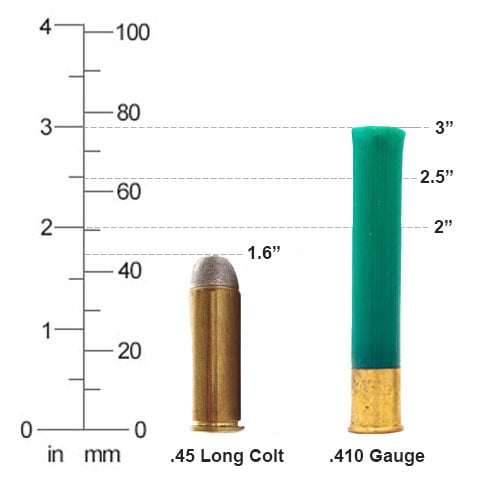
A relative newcomer to the self defense market is a combination handgun called the Judge. This is the only specific gun we’ll review here, and that is because it is a combination of two cartridges placed in one platform.
The Judge is a revolver that will fire either .45 Long Colt cartridges or .410 shotgun shells. You can load them next to each other and they’ll both fire without a hitch.
Why does this have appeal? The idea of a combination firearm that can deliver the blast of a shotgun shell at close range, with the longer hitting power of a .45 Long Colt at greater range appeals to many people looking for a self defense platform.
It’s like a floor wax and a dessert topping mixed into one. It offers the best of both worlds, in an easy to control handgun. The .410 shotgun has a substantial kick when fired from a revolver, something a traditional .410 shotgun isn’t known for.
If you want to try something different in self defense this is it. You won’t have to spend much time on the range with .410 ammo, but the .45 Long Colt still requires target practice to become proficient.
.45 Long Colt Features
| Energy Measured in Foot Pounds at 50 Yards | 407 |
| Energy Measured in Foot Pounds at 100 Yards | 366 |
| Recoil | Moderate |
| Penetration 1-5 (light to heavy) | 4 |
| Effective Range in Yards | 75 |
.410 Shotgun Features
| Energy Measured in Foot Pounds at 50 Yards | 352 |
| Energy Measured in Foot Pounds at 100 Yards | 212 |
| Recoil | Moderate |
| Penetration 1-5 (light to heavy) | 3 |
| Effective Range in Yards | 40 |
Final Thoughts
The choice of a self defense caliber that works for you comes down to personal preference. The power, recoil, and availability of guns to fire your cartridge of choice aren’t just considerations, they’re mandates. You must consider these three factors before choosing which caliber or gauge works best for you.
The market for self defense weapons is a huge one, and it’s growing faster than the sporting realm of handguns, shotguns, and rifles.
Selecting the one that fits your needs takes a little thought, and getting the chance to fire different calibers at shooting range is a positive step in helping you make your decision.